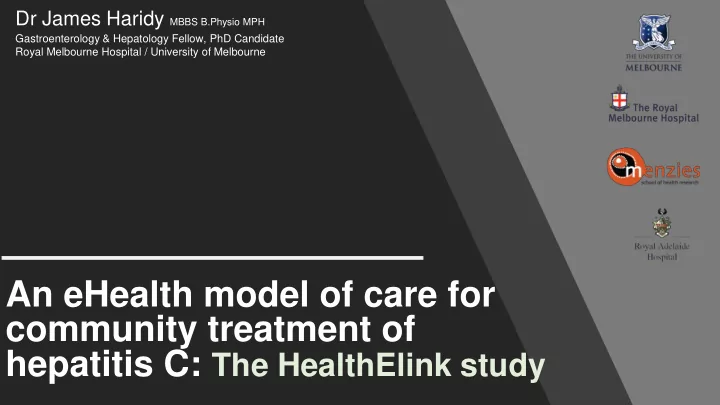

Dr James Haridy MBBS B.Physio MPH Gastroenterology & Hepatology Fellow, PhD Candidate Royal Melbourne Hospital / University of Melbourne An eHealth model of care for community treatment of hepatitis C: The HealthElink study
230,000 Australians Infected 1
We are at an incredible point in history … . 95% SUSTAINED VIROLOGICAL RESPONSE 100% 70% 80% 45% 60% 25% 40% 7% 20% 0% 1990 1998 2001 2011 2016 YEAR @jamesharid Ref 2,3 y
The first 12-months Why do we need GPs to prescribe this treatment? And what are the barriers in the current model of care? @jamesharid Ref 4 y
The current problems.. • Difficult to reach high-risk populations • Concerned about loss to followup • Stigma • Prisons • Potential for missing cirrhosis • Cannot attend specialist / hospital • People Who Inject Drugs • Capacity and access • Rural/Remote • Mental Health • Cost • Simply do not turn up • Indigenous GP Specialist Nurse Patient @jamesharid y
The HealthElink system GP / Nurse / Specialist Portals Patient Portal @jamesharid y
The HealthElink system • Complex treatment algorithm • Multiple treatment plans based on hepatitis C type, fibrosis assessment and medication interactions • Security • Ernst and Young engaged to advised on security, including code review and penetration testing. • Corrs Chambers Westgarth engaged to provide advice on health data privacy compliance. • Data storage on HIPAA compliant Amazon Web Servers @jamesharid y
The HealthElink study Aim To determine the feasibility, efficacy and acceptability of an eHealth system in the community treatment of hepatitis C @jamesharid y
Timeline Development 2014 2015 2016 2017 2018 2019 HealthElink Study @jamesharid y
1. Usability study • 16 users in total over two early versions • Median time for referral HealthElink 538 v 552 seconds • Correct treatment regimen prescribed in 12/12 (100%) v using HealthElink compared with 9/12 (75%) using current paper based form • 12/12 (100%) preferred use of the HealthElink system @jamesharid y
2. The HealthElink Study Prospective multicenter trial Target 500 non-specialist referrals Prison services in NT / SA @jamesharid y
3. Qualitative study – planned in 2018 • Late 2018, purposive sampling of representative usage groups • Users displaying both high and low activity on the system to be interviewed in semi-structured interview • Explore acceptability and motivation behind uptake (or non-uptake) of the system @jamesharid y
The future plan • Trial in other chronic diseases • Further funding to develop system further, enhance compatibility • Mobile / app development to enhance patient experience and interactivity • Refine based on user feedback @jamesharid y
In Summary • Hepatitis C now can be cured, but we still need to get the cure out there • Deficiencies in the traditional model of care preclude rapid and widespread implementation in primary care • An eHealth model of care offers a solution to overcome many of the barriers to eradication @jamesharid y
Acknowledgments & Declarations HealthElink has received funding grants from the Royal Melbourne Foundation, Merck-Sharpe-Dohme and Bristol-Myers-Squibb For more information, visit http://www.healthelinkstudy.com.au This research would not be possible without many others: • Dr Guru Iyngkaran • The Adelaide Liver Group • Dr Edmund Tse • Prof Meredith Temple-Smith • Dr Suresh Sivanesan • Shine SA • Dr Rodney Omond • A/Prof Amanda Nicoll • Dr Jacqui Richmond • A/Prof Geoff Hebbard • DB Results • Prof Danny Liew • Hepatitis Australia • Adelaide and Rural SA PHN • Mr Ian Baker • ASHM
References • Hepatitis C Image: Piver E, Boyer A, Gaillard J, Bull A, Beaumont E, Roingeard P, et al. Ultrastructural organisation of HCV from the bloodstream of infected patients revealed by electron microscopy after specific immunocapture. Gut. BMJ Publishing Group; 2017 Aug;66(8):1487 – 95. • Liver Cirrhosis Image: Courtesy http://www.meddean.luc.edu/lumen/meded/orfpath/images/fig78x.jpg • 1. Hajarizadeh B, Grebely J, McManus H, et al. Chronic hepatitis C burden and treatment uptake in Australia: updated figures at the beginning of a new era [abstract]. HEP DART 2015: Frontiers in Drug Development for Viral Hepatitis. Global Antiviral Journal 2015; 11 Suppl 3: 85-86. • 2. Chart adapted from information contained in: Bertino G, Ardiri A, Proiti M, Rigano G, Frazzetto E, Demma S, et al. Chronic hepatitis C: This and the new era of treatment. WJH. Baishideng Publishing Group Inc; 2016 Jan 18;8(2):92. 3. Australian Federal Government, Department of Health and Aging. Media Release 22 nd December 2015. “Turnbull Government Invests over $1B to cure Hep C”. • Accessible from: http://www.health.gov.au/internet/ministers/publishing.nsf/Content/health-mediarel-yr2015-ley154.htm • 4. The Kirby Institute. Monitoring Hepatitis C treatment uptake in Australia. 2017 July pp. 1 – 7. • 5. Rubin J, Chisnell D. Handbook of Usability Testing. John Wiley & Sons; 2011. 1 p. @jamesharid y
Recommend
More recommend